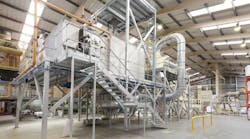Food Processing brings you a special bonus episode of our Food For Thought podcast. In this episode, we're talking with Karl Seidel, Marketing Director for Cablevey Conveyors.
Cablevey Conveyors is a tubular drag conveyor manufacturer that has designed, engineered, and serviced enclosed cable and disc tube conveyors for almost 50 years and in more than 65 countries. In this episode, we're talking about conveyor systems and how Cablevey Conveyors works with manufacturers to ensure materials are moved from Point A to Point B in a safe, efficient, and clean way. Listen as we discuss the types of materials Cablevey Conveyors can handle, how the company helps manufacturers move materials in clean and sanitized ways, as well as how they work with processors to make everything fit within the building envelope.
Transcript
Erin: It's great to have you on, and I really want to dive right in. Can you explain for me and the audience what Cablevey Conveyors specializes in?
Guest Profile: Karl Seidel
Karl Seidel is marketing director of Cablevey Conveyors, a mechanical conveyor manufacturer that serves the specialty food, coffee, nut, powder and pet food markets. The company acts as a disruptor to traditional conveying solutions by manufacturing and commissioning enclosed tubular drag cable and disc systems globally.
Karl: Sure. I'll do my best to explain. Basically, Cablevey Conveyors are a type of conveyor that is enclosed. So, basically, the conveyor has the cable that pulls discs inside of a tube, and we specialize in moving materials gently. So, basically, if you think of cashews or pecans or whole bean coffee at Trader Joe's as an example, and you go to grab a package of cashews or pecans, you'll see that the ones that are whole probably cost twice as much as the ones that are broken. And that's kind of an important distinction in what makes Cablevey stand out, is that our conveyors are designed to move materials gently and avoid breakage.
Erin: I can see from my research that the conveyor systems are ideal for delicate and fragile bulk materials. You just mentioned that as well. Can you elaborate a little more, what kind of materials do these systems typically handle?
Karl: Well, it's a good question. And it's an interesting one in that even though we're listed in the category of bulk conveyors, bulk conveyors don't really define why Cablevey stands out and why we're kind of a niche conveyor manufacturer within a niche. So, we compete against a variety of different conveyors in our category, you know, ranging anywhere from augers to pneumatics to aero mechanical conveyors. And the reason that we stand out is because we specialize in moving materials that have greater value than what they originally started out at. So, basically, if you have a hard coffee bean, a green bean as an example, and that green bean is difficult to break, well, soon you add value to it by roasting it. And once you roast it, it expands, and it becomes fragile. So, when you're moving it from, you know, basically your roaster to a degasser or from a degasser to a packaging line, if it's being broken, it is less valuable to the end consumer. So, the same can be applied to a variety of things like roasted coffee, nuts, snack foods, crackers, potato chips, popcorn, pet food, etc. In other words, additional value has been put into these materials which often defines the difference between something that started out as a raw material, but is now a specialty product because more value has been added to it because of the processes it's recently gone through, roasting, baking, combining, blending, etc.
Erin: Say I was a food processor for a very fragile material I needed to move from point A to point B, and to have a building footprint I couldn't really adjust to bring in a new system. Seems like I would need a conveyor system that could move around the equipment that I already have. Is that something Cablevey Conveyors can help with? And also, can you explain how you work with processors to fit their conveying needs?
Karl: When we talk about our conveyors, we talk about the tube diameter, and the tube diameter, to some degree, brings us to what actual cubic weight can be conveyed inside of that diameter tube, that particular diameter tube. Let's say, for instance, we have a 2-inch diameter tube and that can move maybe just over 500 pounds of materials per hour, depending on the cubic weight of the material itself, whereas we also have an 8-inch version of that. So, you need to move 80,000 pounds per hour, you'd choose an 8-inch conveyor. The point being that these are tubes that you kind of snake along inside of your facility. You can be almost right up to the ceiling with them because there's nothing above that would conflict, except for a hanger. In other words, you're going to hang the conveyor, the 2-inch tube or the 8-inch tube, right underneath your roof.
Get in Touch with Cablevey Conveyors
Cablevey Conveyor reps are geographically based around the world. You can get in touch with them through email at [email protected], or visit their website www.cablevey.com.
So, you know, that needed to be done and needed to be snaked through a variety of lines, or above or below or in between. That can be done and is often done because our systems operate on multiple planes, and because they operate on multiple planes, if we need to elevate a tube at a certain angle or we need to go around an obstruction, another machine, maybe another processing line, we can do that with relative ease. In other words, if it's planned in advance properly, our conveyors can fit in most processing environments. That sorta kinda explains how we work with processors to fit their conveying needs. Although that's probably much deeper question that's going to have to be answered on a case-by-case basis because our systems are all custom.
We have the basic components to begin with. In other words, we have a turnaround unit that has a sprocket, we have a drive unit that has a sprocket. The drive unit will pull the cable and disc through the tube, and you'll have an empty side and you'll have a side full of materials. So, basically, if we're working with a processor and they're trying to define what's going to work best in their environment, you know, they're going to give us a plant layout. They're going to basically say, "This is what I envision." And then either we'll agree or we'll disagree, but we'll try to get to the point where we agree on what is the best way to move this material from point A to point B. And, you know, once we arrive at some understanding of what that's going to look like, that gets drawn out. And once it's drawn out, it becomes easier, of course, to discuss what the system is going to look like inside of that plant and, of course, how much it's going to cost.
Erin: Food and product safety is always a huge concern for processors. How does one clean and sanitize Cablevey Conveyors' tubular drag conveyor systems?
Karl: The easy explanation is that, because we have an enclosed environment, we have control over how materials are both entered into the system and purged from the system.
We have a variety of cleaning methods that include both dry and wet considerations. So, if you have a system or if you have materials that are going to go through a system that you don't ever want to introduce anything that's wet to, well, then we have dry systems that have brushes and air knives to accommodate the cleaning of the system after materials pass through. In fact, we've had a number of systems which, I think, offer an advantage over competing systems because we have some simple methods that can be employed, especially with conveying dry materials.
With conveying dry materials, you know, you're always going to end up with a certain amount of fines—the stuff that's left over after you moved the main material. So, those fines automatically get swept through the system and basically swept out of the system each time the cable and disc go around a circuit in the system. And we do that by using a urethane disc. So, you have urethane disc in there, it acts a little bit like a pig in that it's a wider diameter than the tube itself, so it clears everything out because the urethane disc itself comes through the system after every go-round of any material that's being conveyed during the process. So, that's one approach on the dry side.
We also have systems that...and everybody has their own sanitary level or level of sanitary or cleanliness that they might point to in their own system. You know, that's another subject entirely, but having said that, we do have systems, wet clean systems that are considered clean in place. So, basically, we have these methods where we can send water and sanitizer, aseptic cleaner through a system to clean it.
Erin: I imagine, too, with such small particle sizes that dust explosions would be of concern. How can Cablevey Conveyors help reduce the likelihood of that happening?
Karl: It's a good question. And we've tried to address that in a couple of different ways in terms of how dust explosions occur. My understanding is that dust explosions occur when you have enclosed systems that don't allow air to circulate. So, if there is something that triggers or ignites something within the system, whether it's a fragment or a fine or a particle of some type, it has the flame or whatever is combusting has nowhere to go. So, it will combust.
Our systems actually have air going through them from start to finish because the oxygen doesn't build up, we can displace the oxygen using nitrogen if necessary, but more often than not, it's just going to be air flowing through our system. So, it's not a sealed tight system, like a pneumatic as an example. My understanding is that most dust explosions that we read about and that we have heard about in this industry are mostly occurring inside of facilities that are using pneumatic conveyors, and pneumatic conveyors are sealed. So, how do you displace the air to avoid a dust explosion inside of the sealed system? I think that's the question that you have to ask when you're talking about dust explosion, and I have never heard of a Cablevey conveyor being involved in a dust explosion.
Erin: If anyone would like any more information about Cablevey Conveyors or to learn more about what you and your team are doing, how can they get in contact with either you or anyone from Cablevey Conveyors?
Karl: Well, that's easy enough. Our reps are geographically based around the world. The best and easiest way to initiate any kind of contact is to send us an email [email protected], or visit our site, that's www.cablevey.com. And if you'd like to contact me personally, you're certainly welcome to. My name is Karl Seidel. So, it's [email protected].
Erin: Great. Thank you, Karl. I appreciate you joining me today. It has been an absolute delight to talk to you and to learn more about Cablevey Conveyors' capabilities today. Thank you so much for joining me and thank you to everyone for listening to today's special bonus episode of the Food For Thought Podcast.




